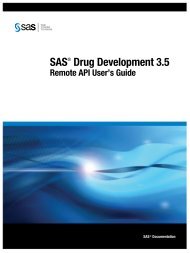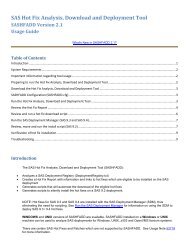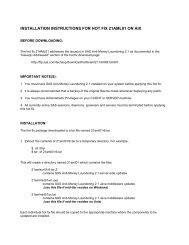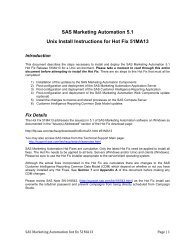SAS 9.3 Web Applications: Clustering - Index of - SAS
SAS 9.3 Web Applications: Clustering - Index of - SAS
SAS 9.3 Web Applications: Clustering - Index of - SAS
You also want an ePaper? Increase the reach of your titles
YUMPU automatically turns print PDFs into web optimized ePapers that Google loves.
2 Chapter 1 / Overview<br />
machines in the middle tier, do not use the <strong>SAS</strong> Deployment Wizard. Instead,<br />
copy selected directories and configuration files from the first machine.<br />
4 Prepare for <strong>Clustering</strong>: Manually configure <strong>Web</strong> application servers and the <strong>SAS</strong><br />
<strong>Web</strong> applications to take advantage <strong>of</strong> clustering. You might need to configure<br />
resources such as JDBC data sources and Java Messaging Services. The work<br />
to perform during this step depends on the number <strong>of</strong> clusters, the number <strong>of</strong><br />
servers within each cluster, and whether <strong>SAS</strong> <strong>Web</strong> applications are relocated to<br />
new <strong>Web</strong> application servers.<br />
5 Cluster: Create the <strong>Web</strong> application server cluster. <strong>Web</strong>Logic Server and<br />
<strong>Web</strong>Sphere Application Server provide administrative interfaces that assist with<br />
creating a cluster. For JBoss Application Server, the cluster is based on multiple<br />
stand-alone servers.<br />
6 Perform Post Configuration for the Cluster: After creating the cluster, configure a<br />
load-balancing HTTP server so that user requests are load balanced and routed<br />
to the clustered servers. The <strong>SAS</strong> <strong>Web</strong> applications rely on session affinity, also<br />
called “sticky sessions.” This feature ensures that subsequent HTTP requests for<br />
the <strong>SAS</strong> <strong>Web</strong> applications are always routed to the same <strong>Web</strong> application server.<br />
7 Validate the Cluster: Perform a series <strong>of</strong> logon attempts to confirm that loads are<br />
distributed across the servers in the cluster. Afterward, perform more intensive<br />
tasks to confirm that the cluster meets your performance and high availability<br />
requirements.<br />
<strong>SAS</strong> Middle-Tier Limitations<br />
<strong>SAS</strong> Workflow<br />
Java Messaging Services<br />
The <strong>SAS</strong> Workflow <strong>Web</strong> application must be modified with manual configuration<br />
steps to be used in a cluster. For sites that do not need performance and scalability<br />
for <strong>SAS</strong> Workflow, the <strong>Web</strong> application can be deployed to a stand-alone server<br />
without modification.<br />
A Java Messaging Service (JMS) server and the JMS resources are used by the<br />
Event Generation Framework <strong>Web</strong> application, <strong>SAS</strong> Workflow, and <strong>SAS</strong> <strong>Web</strong><br />
Infrastructure Platform Scheduling Services. Each <strong>Web</strong> application server vendor<br />
<strong>of</strong>fers different strategies for providing JMS resources in a clustered deployment.<br />
For JBoss, this document describes using a dedicated, single JMS server that is not<br />
to be shared with other application Java virtual machines (JVM). The clustered<br />
server instances are configured to use external Java naming and directory interface<br />
(JNDI) contexts to the JMS resources on the stand-alone server.<br />
For <strong>Web</strong>Logic Server, this document describes leaving the JMS server on the standalone<br />
server. The JMS resources are made available to the servers in the cluster by<br />
configuring a JMS module and destinations that treat the JMS server on the standalone<br />
server as a foreign JMS server.<br />
IBM <strong>Web</strong>Sphere Application Server Network Deployment can provide JMS<br />
resources in a cluster and make the resources available to the cell with few

















